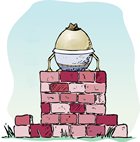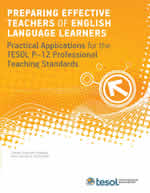Lesson Plan: Fishing for Nursery Rhymes
by Sarah Sahr
 One of the greatest things about teaching really young learners is how they are just like sponges, soaking up huge amounts of information, especially when it comes to songs and rhymes. Nursery rhymes are a great way to not only teach speaking patterns but also a little bit of culture. This reading and listening lesson assumes students already understand the concept of rhyming and a little bit about fishing…
One of the greatest things about teaching really young learners is how they are just like sponges, soaking up huge amounts of information, especially when it comes to songs and rhymes. Nursery rhymes are a great way to not only teach speaking patterns but also a little bit of culture. This reading and listening lesson assumes students already understand the concept of rhyming and a little bit about fishing…
| Materials: Several 3”x5” cards, plastic rulers (plastic rulers work best because they have holes), string, magnets, picture print outs, paperclips |
| Audience: Early primary, upper-beginner to intermediate language proficiencies (Grade 2 might be the best age for these activities) |
| Objectives: Students will be able to recognize a variety of nursery rhymes by “fishing” for the correct item. |
Lesson Prep
Make rhyming cards
On 3”x5” cards, write the following words in big block letters:
|
snow |
wall |
moon |
be |
|
go |
fall |
spoon |
three |
|
rule |
diddle |
dub |
wife |
|
school |
fiddle |
tub |
life |
Make fishing poles & “fish"
Construct as many fishing poles and sets of “fish” as the number of groups you will break your students into.
Fishing Poles
- Tie about two feet of string to a plastic ruler.
- At the other end of the string, tie a magnet. It’s best to use small horseshoe or ring magnets.
Sets of “Fish”
- Print and cut out pictures of nursery rhymes on card stock (make sure to have at least one set of five different nursery rhymes for each group). On the back of each picture, write the title of the nursery rhyme it depicts in big block letters.
- Fasten a paperclip to each picture.
Nursery Rhymes
Mary Had a Little Lamb (Photo) (Print)
Humpty Dumpty (Photo) (Print)
Hey Diddle-Diddle (Photo) (Print)
Rub a Dub Dub (Photo) (Print)
Three Blind Mice (Photo) (Print)
Great Websites to find nursery rhymes:
Nursery Rhymes - Lyrics, Origins & History!
Nicky’s Nursery Rhymes
Zelo
Introduction
Gather students together on the floor for a reading and listening activity (a reading corner or area with carpet works best). Read a few nursery rhymes from a book. These nursery rhymes will be used throughout class. If necessary, you could read the nursery rhymes more than once, just to get the students excited about the rhyming patterns and silliness of nursery rhymes. While students are still on the floor, make small groups of three students each. Give each group a set of rhyming cards, mixed up. Groups will have to match the words that rhyme. As a class, match a few pairs of cards together. Once students get the idea of what needs to be done, have them complete the last pairs on the floor in their groups, sitting in a triangle.
Once groups have finished matching all the rhyming cards, read the nursery rhymes again, one at a time. At the end of the reading, ask students, “Which words go with this nursery rhyme?” Students should identify the words that go with the correct nursery rhyme. (Repeat this function for each nursery rhyme.) Once all the rhyming cards have been matched with the correct nursery rhyme, ask each group to come up with more words that rhyme with the sets.
By now, students should be familiar with each nursery rhyme.
Information
With the students still in groups and the matched words on the floor, hand out the “fish.” Students should place the “fish,” picture side up, with the correct set of words. The teacher should walk around helping each group. Once all pictures are matched, and if there is time, read the nursery rhymes again. If possible, have students say the nursery rhyme with you.
Create the “pond”
Leaving the “fish” on the floor so that each paperclip can be seen, collect the rhyming cards from each group of three. The collection of pictures on the floor is now a “pond of fish,” with each group having their own “pond” to fish in.
Bring out “fishing poles” and demonstrate
Quickly, teach students how to fish. The magnet at the end of each “pole” will pick up a paperclip and, therefore, students will be able to catch a “fish.” Allow all students to practice fishing.
Time to Fish!
One student per group will have a fishing pole. Read a nursery rhyme. While you are reading, the student with the fishing pole has to catch the “fish” that matches the nursery rhyme, from among the group’s full set of “fish.” When the student catches the “fish,” he or she should hold it up over his or her head so you can see that his or her group has finished. (If a student catches the wrong “fish”, he or she should place it back in the “pond” and try again.) Once complete, repeat the activity with a new student fishing each time you read a new nursery rhyme.
If time allows, turn the “fish” over and do the same activity with the titles of the nursery rhymes, not the pictures.
Once the class has finished fishing, collect fishing poles and put them someplace safe for reuse. You can use them for almost anything. For example: Call out shapes, colors, vocabulary words, or math problems with the solutions on the floor, and have students “fish” for the correct answers. The list of possibilities is endless!
Closure
Bring students back to their desks and project the nursery rhymes on a wall, one at a time. (This can be done with large chart paper, an overhead projector, or LED.) Read them together as a class.
Ask any students if they want to read the nursery rhyme alone, with no help.
_______________________________
Sarah Sahr works at TESOL and has her Masters in ESL administration. She has managed a school in Vietnam, trained teachers in South Korea, implemented school reform in Qatar, run a circus train classroom for Ringling Bros. and Barnum & Bailey, and taught 8th grade writing in Maryland. Prior to all that, Sarah was a Peace Corps Volunteer in Ethiopia. She is also a certified ashtanga yoga instructor and has managed an eco-lodge in Chugchilan, Ecuador.
TESOL Bookstore
Just Off Press!
 Preparing Effective Teachers of English Language Learners:
Preparing Effective Teachers of English Language Learners:
Practical Applications for the TESOL P-12 Professional Teaching Standards
provides guidelines, examples, and strategies in applying the TESOL P–12 Professional Teaching Standards for
-
the creation of new or revised ESL teacher education programs
-
national recognition through the National Council for the Accreditation of Teacher Education/ Council for the Accreditation of Educator Preparation (NCATE/CAEP)
-
professional development of in-service ESL teachers as well as content area teachers who work with ELLs.
Authors Diane Staehr Fenner and Natalie Kuhlman bring their extensive knowledge of the Standards and offer step-by-step applications using the five domains of Language, Culture, Instruction, Assessment, and Professionalism. Readers find new directions, ideas, and ways of thinking about how programs prepare teachers who teach English language learners in the United States as well as around the world.
Special Introductory Price $58.00
(After 1 May 2012, Retail List: $79; Member Price: $65)
Order from the TESOL Bookstore
Toll Free: 888-981-0041
E-mail: tesol@brightkey.net
Order #738
ISBN 9781931185738
What People Are Saying...
"This very practical book can be used to prepare pre-service and in-service teachers so that their English language learners will meet student standards. The book provides guidance in designing programs for ESL teachers or additional certification programs. Most important, it provides a framework for professional development programs that is built on the TESOL P-12 Professional Teaching Standards that will benefit ESL as well as content area teachers."
Margarita Calderon, PhD
Professor Emerita/Senior Research Scientist
School of Education, Johns Hopkins University
"One of our nation’s greatest challenges is to meet the needs of all its P–12 learners whose first language is not English. This imperative is paramount both for moral and economic reasons. In today’s economy, academic success is a necessary foundation for economic well-being. We will not achieve that goal without high-quality teacher preparation programs. As we raise the bar for our P–12 students, we must also do so for the programs that prepare our teachers. I congratulate TESOL on this timely and practical volume."
James Cibulka, President
National Council for Accreditation of Teacher Education
and Council for the Accreditation of Educator Preparation